When there were no napëpë [non-Indigenous; enemies], when we lived alone, before contact, we weren’t like this. Today, some babies come out before their time [miscarriage], some [women] bleed [excessively] from their vaginas. My daughter lost her baby…The place where our ancestors lived was very clean; that’s why we were fine. Now we’re close to where the white people are and that’s why we’re doing so badly.
It is 3:30 in the morning inside the collective house in Monopi village. In the middle of the night, the voice of an older Yanomami woman whom I can’t identify mixes in with dreams and the chirping of crickets in the forest. She is giving a public speech known as a hereamu, an oration done only at night and by people who have some authority in the community, usually men.
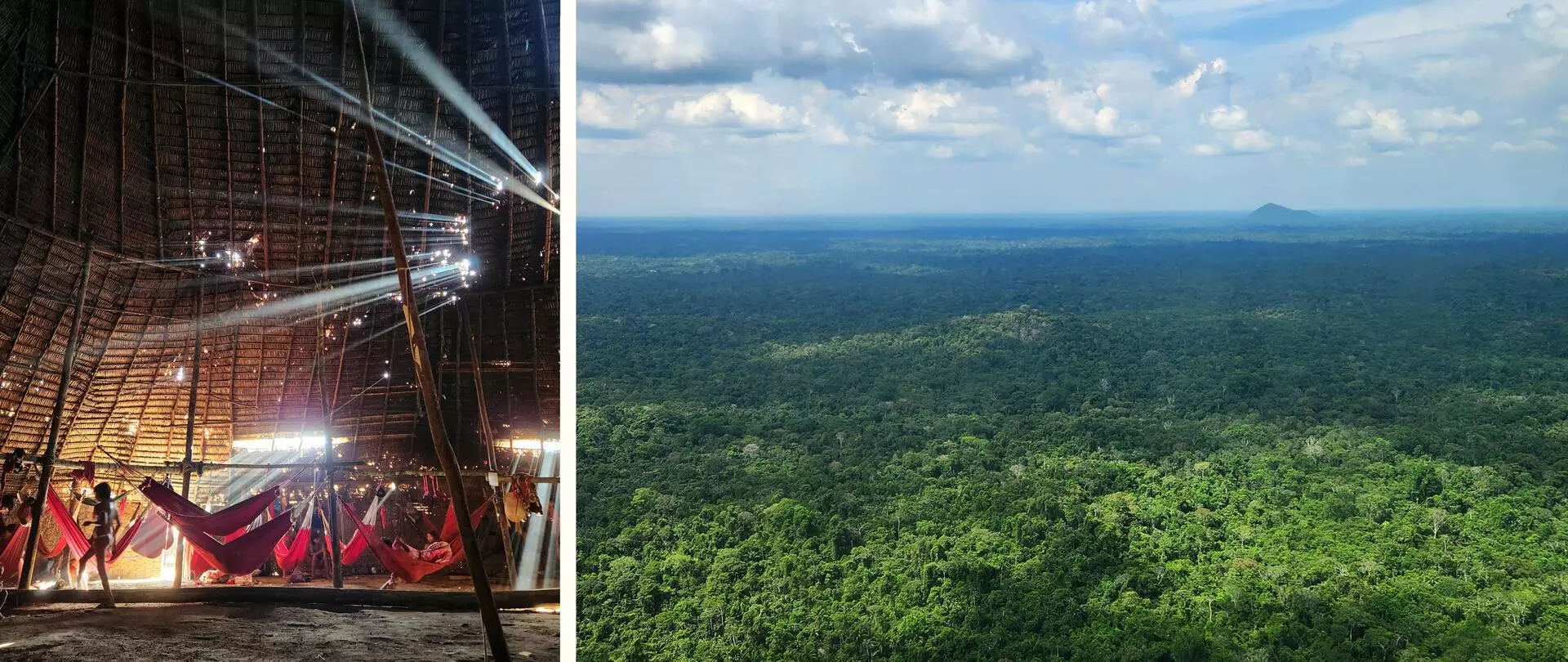
Collective house in the Monopi community, in the Catrimani Mission region. The Yanomami Indigenous Territory has around 370 villages. Photo: Ana Maria Machado/ISA
In the Monopi house, older women from various villages take turns orating. People who are already awake listen and sometimes comment on what is being said. It’s five o’clock in the morning now, and with the light of dawn seeping into the conical, pitched-roof maloca, I can see more than 70 hammocks spread around the building. At least 55 of them are occupied by women who are there to take part in the 14th Gathering of Yanomami Women, an event held in Yanomami Indigenous Territory since 2008. This year, it is attended by Yanomami women from 27 of the territory’s more than 370 villages.
This is the first gathering to take place since the end of the Jair Bolsonaro administration, during which thousands of miners invaded the territory, bringing diseases and hunger to the Indigenous. The mood is one of reconstruction but also of apprehension. Although the administration of Luiz Inácio Lula da Silva set up a health taskforce early this year and heightened environmental oversight, there is still much to be done. The key issue addressed during the seven-day gathering is women’s health, a concern abandoned under the previous administration.
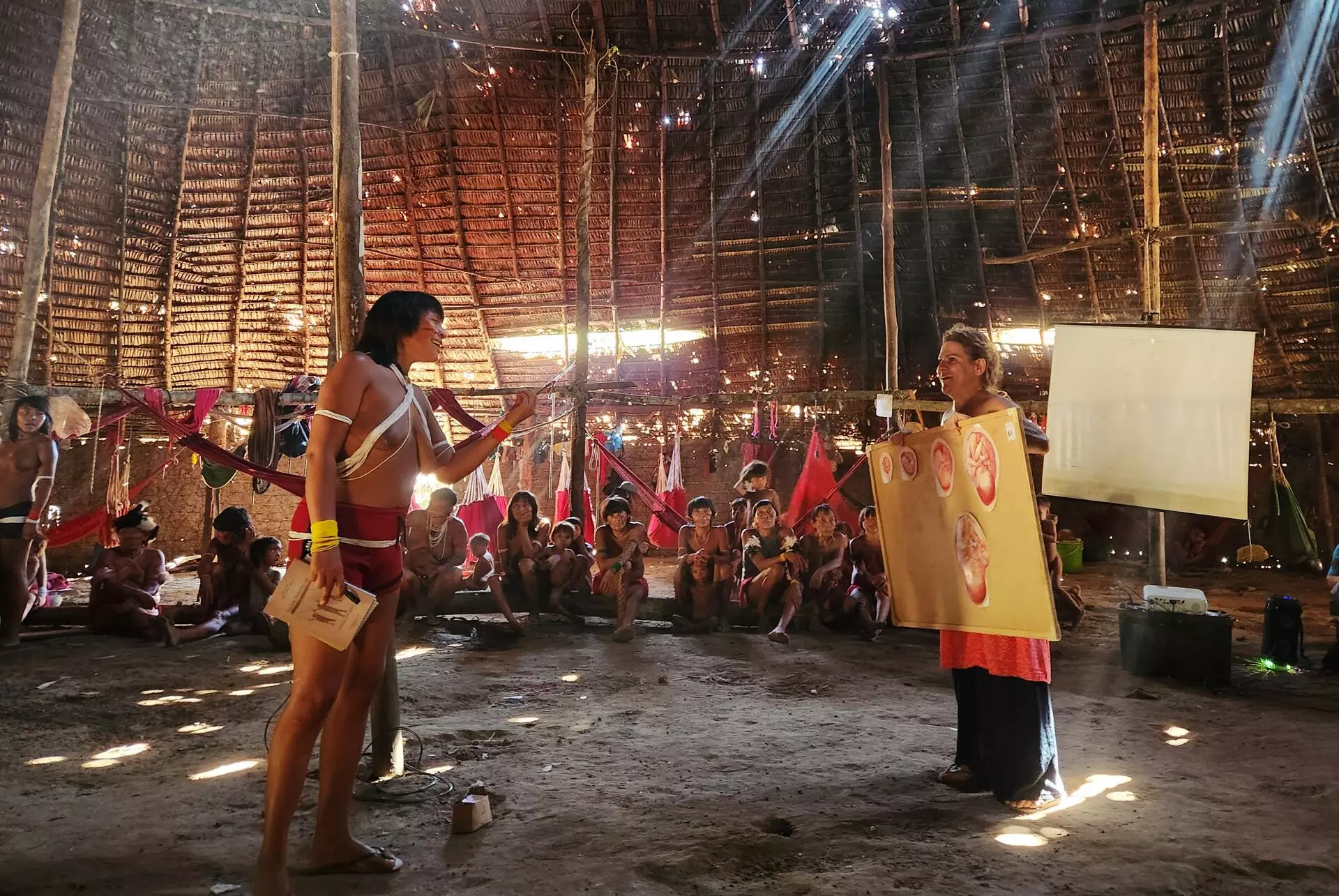
Yanomami women, like Ehuana Yaira (left), and non-Indigenous women, like Ana Paula Pina (right), work together to define the bases of health policies. Photo: Ana Maria Machado/ISA
“Why are our vaginas bleeding so much?”
Inside the maloca, conversations continue into the morning, but in the afternoon, the scorching heat caused by climate change and El Niño has us searching for a clearing in the forest where we can continue our talk. One of the women stands up in front and begins addressing the group:
Before, our ancestors didn’t have pain; they were fine. But here, near where the napëpë live, we’ve begun having a lot of pain, and that really worries me. Why do our vaginas bleed so much?
These women have witnessed many changes to their reproductive and sexual health over the years. Due to a lack of organized data, it isn’t possible to say what the rate of sexually transmitted infections (STIs) is in the villages of this territory, nor to provide clear answers to the women’s questions. They say the situation has been getting worse. Over the past four years, a perfect storm has led to the collapse of women’s health, with healthcare programs being dismantled and illegal gold mining advancing into Yanomami territory.
The miners’ invasion of the Yanomami Indigenous Territory intensified dramatically in 2019, when the price of gold skyrocketed on the world market, the Bolsonaro administration let oversight slide, and the former president made statements that encouraged illicit gold mining. Thousands of men invaded the territory, and in the hardest hit regions, sex workers were brought in from Boa Vista, capital of Roraima. Many Yanomami girls and women also ended up prostituting themselves. Girls as young as 11 have been raped and assaulted by moxi xawarapë, “diseased penises.” In regions where there is not a large presence of gold miners and clubs, the main source of STIs are the Yanomami men who make frequent trips to cities, where some get involved with women and return to their communities infected with diseases like HPV, syphilis, and genital herpes. “When the men go there today, they have sex with bad vaginas and get infected,” one woman said during the meeting.
When the older women speak, they always express a great deal of concern about their daughters’ and granddaughters’ health during pregnancy. “I’m very worried about these diseases; children aren’t being born well. […] Our children are being born rotten. Could it be that these diseases are doing that to them? It makes me sad to think about it.”
There are countless reports of women having miscarriages. Their bodies expel their babies long before they are due, and they give birth to children who have fetal malformations, are underweight, or, if they survive, are constantly ill. The older women are unanimous in saying that before, when they were young, they weren’t like that. Only an in-depth study could ascertain the reasons for so many fetal malformations and miscarriages—specifically, whether there is a relation between them and some STIs or the mercury used by the mining industry—but the Health Ministry has conducted no such research. A report released by the Federal Police in 2022 on the contamination of rivers in Yanomami Indigenous Territory found that four of them had mercury levels 8,600% higher than the maximum stipulated for drinking water.
The challenge of rebuilding the women’s health program from the ashes is enormous. In recent years, routine gynecological exams, such as the pap smears essential in cervical cancer screening, are no longer part of visits at health posts in Yanomami territory. Without this test, some women discover their cancer too late. There have been failures in prenatal care as well. Brazil’s Health Ministry recommends at least six medical visits during pregnancy, but from 2020 to 2022, this protocol was followed in the case of only 4.6% of pregnant Yanomamis, on average; moreover, 38.2% of them had no prenatal appointments, according to data obtained by SUMAÚMA through the Access to Information Act. Good prenatal care is essential for identifying complications during pregnancy, reducing maternal and infant deaths.
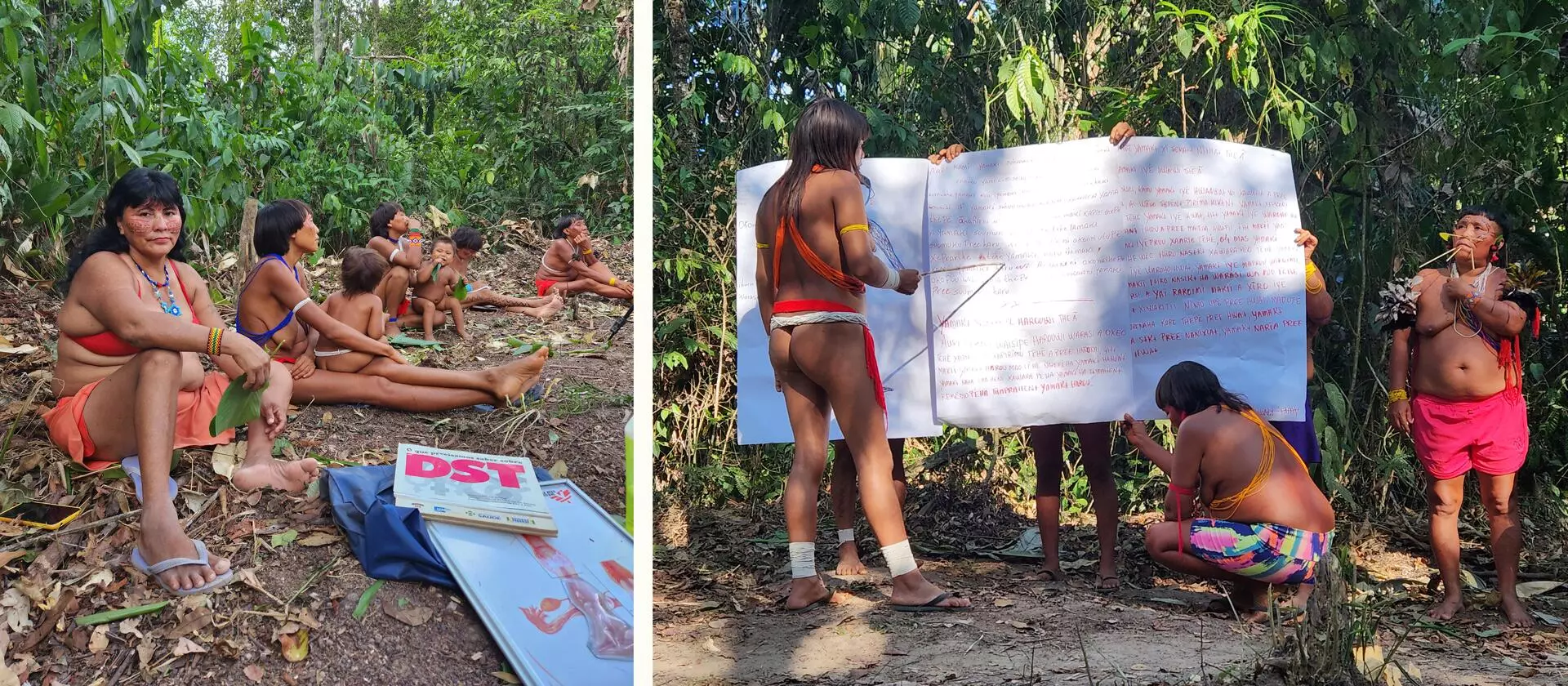
On blistering afternoons, the heat drives the meeting into the forest, where it is cooler. Photo: Ana Maria Machado/ISA
Illegal mining is back
This year, four women from the uplands region of the territory attended the gathering. They live in some of the areas most affected by mining, hunger, malnutrition, and malaria. Now, almost a year into the Lula administration, the gold miners are returning full force, as Simone, a prominent regional leader, tells us.
The miners have just come back, and that’s why I’m crying. I’m a shaman, and that’s why I’m speaking up. The miners have gone back to dirtying my water, ripping open my soil, digging holes again. Why do the miners behave so ignorantly? They’ve already ruined my Yanomami people; they’ve left them infected with worms, diseases, diarrhea; they’ve ruined our children. They’ve brought death to many of my people. […] The miners don’t help us; they just make babies [in our women].
The return of mining also means Yanomami health is deteriorating again. While the price of gold continues to rise on stock markets around the world, reaching an all-time high in December 2023, the waters of Yanomami rivers grow muddier, and more contaminated with mercury. I watch the children in Monopi playing in the water, cooling down on these absurdly hot days. Women walk through the forest lugging pots and bottles of murky water, probably tainted with mercury. This is the water they have to drink and cook with. The river is life in these communities. Only 13.1% of the villages have water supply infrastructure and many of them don’t have any clean streams nearby, forcing them to drink contaminated water.
During the gathering, many women complain the fish are now flavorless. A woman leader from the Haxiu region says, My children are hungry for meat; they eat rotten fish and all get diarrhea. While she is speaking in the middle of the maloca, the woman’s baby, just a few months old, clings to her breast. One of the risks of mercury poisoning is neurological damage in babies. The metal crosses the placenta and also enters the breast milk. Many of these problems only become obvious as the child grows.
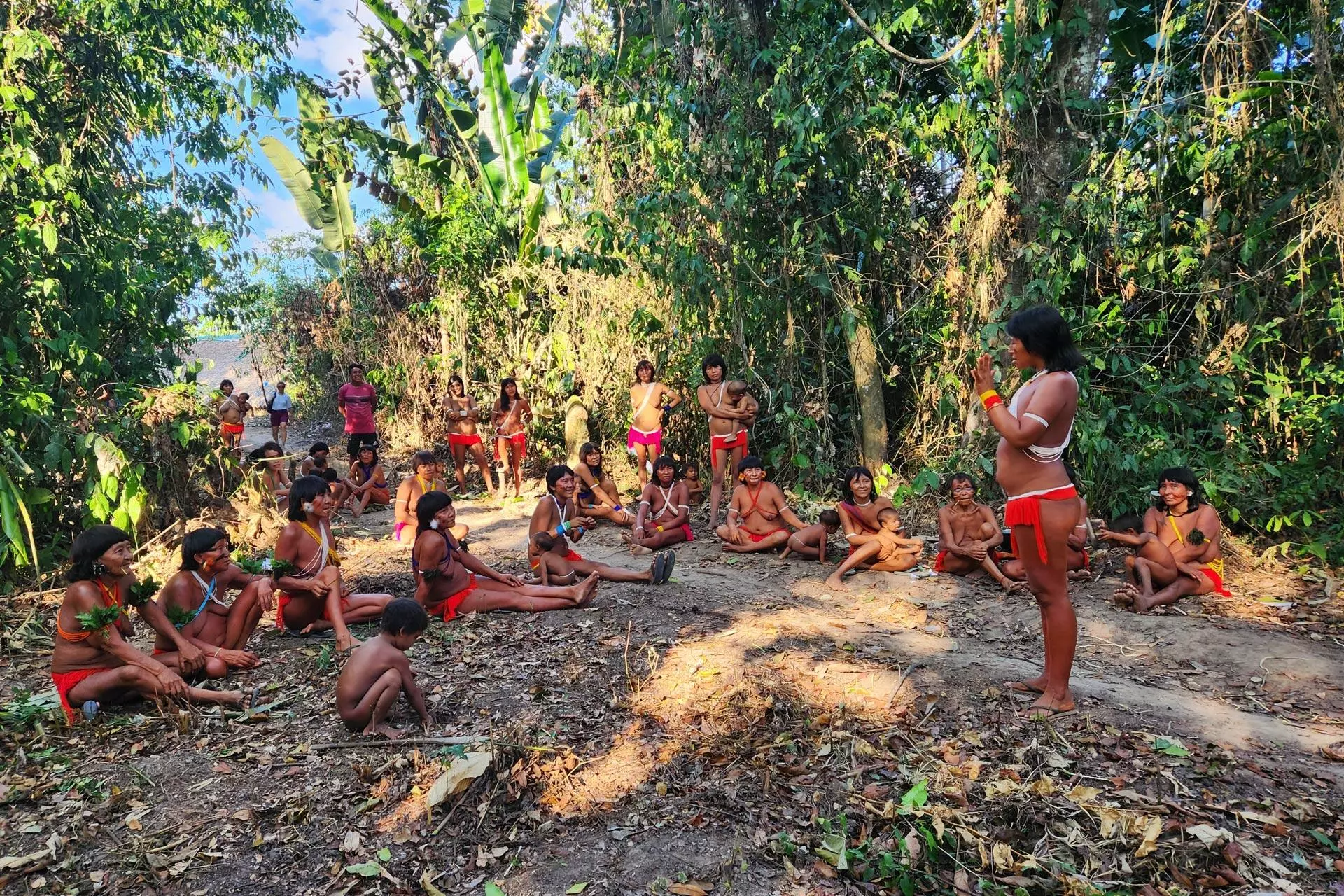
During the gathering, women discuss the contraceptive methods available through Brazil’s national healthcare system SUS. Photo: Ana Maria Machado/ISA
The war against the illegal exploitation of the Amazon may even cool down, which is how things have gone since the beginning of the Lula administration, but greed has deep roots, and there is no end to exploitation. “Peace” is a noun that doesn’t seem to fit into Yanomami life. Some gold miners never left the territory, and since late September, Yanomami associations have been receiving reports of miners returning to regions from which they had been kicked out earlier this year.
“All the Yanomami are crying”
If you go to my community, you’ll see all the Yanomami crying. […] You’ll see that everybody has malaria. My people back in my community died; my daughter back there cried; and I came here. One of us died, and then another one died too.
This account was given by one of the women from the uplands region on the first day of the gathering. It is suspected, although not confirmed, that both people who died in the region had malaria. Two days after her arrival, this woman no longer had the strength to get out of her hammock; she was burning with fever and very weak. She tested positive for malaria. Of the four women and two children who came to the gathering from the uplands, half had malaria.
Some malaria control measures are being taken in these communities, but the challenge is huge, particularly because the return of the miners may make it impossible for health teams to visit various regions, leading to a consequent lack of control over diseases. Data compiled by the Health Ministry’s agency for epidemiological surveillance, SIVEP, show that between January and September 2023, 22,174 cases of malaria were reported in Yanomami Indigenous Territory, a remarkably high rate for a population of just over 31,000, according to the Health Ministry itself.
When malaria strikes, it weakens the whole body, which was the case with a two-year-old from a community that receives little health care. The toddler, who had accompanied his mother to the meeting, stood out sharply among the many children in the host community. He spent the day huddled up against his mother, sucking her shriveled breasts. He weighed 17.5 pounds in March but by November was down to a little over 13 pounds. He had caught malaria several times in a row and was suffering from tapeworms.
The health team, made up of a nutritionist and nurses, was quite concerned about the child. They offered him supplements mixed with porridge, but the child refused it. He grew so weak that his mother took him to the shaman for treatment. In the dim light of a few lanterns and a campfire, the shaman Miguel chanted the songs of xapiripë spirits and laid his hands on the boy’s skinny body and wrinkled skin, as the child lay in his mother’s lap. The shaman told me the disease came from white people and he couldn’t cure it. The health team was called in and, with the consent of the shaman, who continued his own work, the nurse decided to give the boy IV fluids.
The next day the two-year-old was taken to a hospital in Boa Vista, in the company of his mother and grandmother—whose minds weren’t put to ease by the transfer, since a few months earlier, another child from their community had been sent there as well but had returned inside a small coffin. Fortunately, after spending about two weeks in the hospital, the little boy is now recovering. But many children have not been as lucky. According to data furnished by the Health Ministry’s Center for Emergency Public Health Operations in Yanomami territory, between January and September of this year, 29 people died of malnutrition and another 23 of malaria, children being the main victims. Of the 215 deaths registered by the Special Indigenous Public Health District in Yanomami territory during this same period, 53% were children under the age of four.
Being resistant
The late afternoon light paints the sky shades of pink, as pairs of macaws cross the horizon. After the meeting, the Arapari River is filled with women and their children. It’s a carefree moment, and I have fun listening to their jokes about men, vaginas, and nudity, often followed by guffaws. The women remind me that joy, humor, and leisure are important allies, even when you live in a territory that seems to be the perpetual setting for capital’s war on nature.
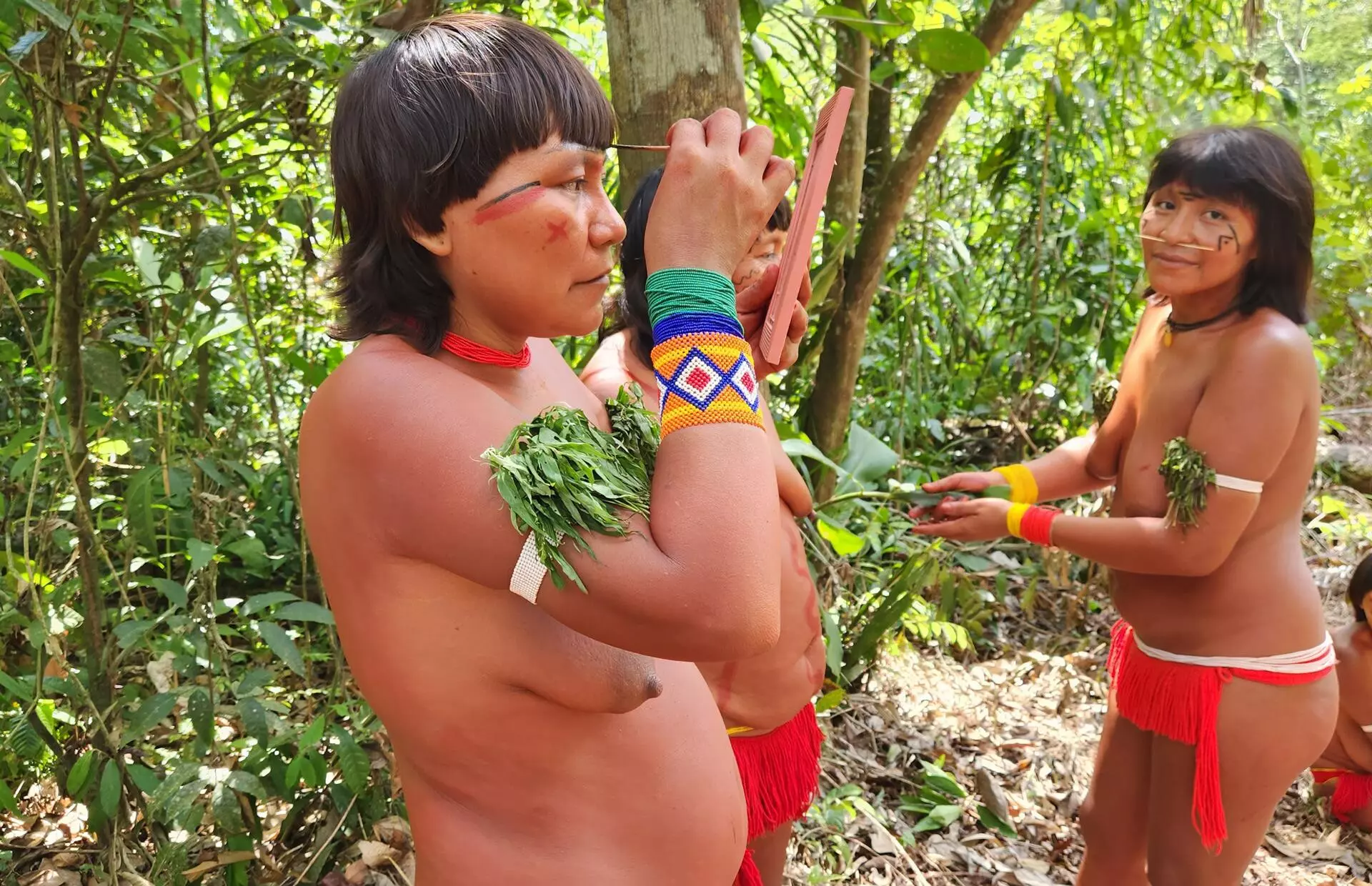
Before festivals and other events, Yanomami women, like Guiomar (right) and Ehuana (left), paint themselves with annatto planted in their gardens. Photo: Ana Maria Machado/ISA
But this group doesn’t give up the fight. Last year, the Women’s Gathering took place just after the news that Lula had won the presidential elections, and the atmosphere was one of hope. The women composed a letter calling for an end to illegal mining and for improvements in health care and education. They wrote: “Lula, we are happy to know you are going to be our president, that you will know how to listen to us and count on our participation in your government.” The letter was hand-delivered to the president when he visited the Indigenous Health Support House in Boa Vista on January 21 of this year, one day after he had declared a Public Health Emergency of National Concern about Yanomami health. This decision came in reaction to SUMAÚMA’s revelation the day before that during Bolsonaro’s four years in office, 570 children under the age of five had died of causes that could have been avoided if medical care had been available.
More than ten months into the new administration, little has been done to address the concerns laid out in these women’s letter. They are waiting for more energetic responses from the government: illegal mining must be combatted in Yanomami territory, the airspace must be closed again, and the logistical scheme that supplies criminals must be shut down. The Armed Forces are silently withdrawing from actions to combat criminal mining, according to Yanomami leaders and associations. In addition, public health care has still not responded satisfactorily to the humanitarian crisis, and many Yanomami continue losing their lives to treatable, preventable diseases.
When contacted, the Defense Ministry did not explain why it is withdrawing from the territory. It only said that “the logistical support provided by the Armed Forces in Yanomami Territory is emergency in nature and aims to meet needs until the agencies assigned this task as their end goal can implement lasting solutions.”
In a written statement, the Health Ministry said the healthcare operation set up by the federal government early this year has provided over 13,000 medical services, reopened 35 healthcare posts, and sent 117 providers from the federal More Doctors program to the region. “With regard to women’s health, it is worth emphasizing that maternal mortality, sexual infections, sexually transmitted diseases, among other problems, are the product of social disorganization, the loss of the ways of life of original peoples, [which are] consequences of neglect and mining.” The ministry says specific initiatives are underway in the places most affected by the mining invasion in an effort to identify cases of sexually transmitted infections, cervical cancer, and pregnant women in need of prenatal care. The ministry also says it has extended access to the HPV vaccine in the territory to include people up to the age of 18.
This loveliest of forest gatherings draws to a close. Several canoes are now making their way down the Arapari, which meets the Catrimani River, whose extremely muddy waters denounce the heavy presence of gold miners upstream. Camila, who lives in a house nearby, tells me she is sorry about the fish and contaminated water she has to drink. Sometimes it seems there is no future in the Amazon, and it is disheartening to see how the lives of the Yanomami and the rainforest depend on tenuous decisions made by those in the presidency, Congress, and Armed Forces. The conversations that began well before sunrise still echo inside me.
This was a gathering in the deepest sense of the word. It was fertile soil where seeds were planted and then blossomed to rebuild new paths in a devastated land. As I ponder the future, I look over at Camila, who is gazing serenely at the forest horizon. I remember her mother, Chiquinha, and also Ehuana, Fátima, Simone, Irokoma, Guiomar, Salomé, Maria, Nilsia, Rita, Suhuma, Suzana, and so many others. Resistance also lives here, inside Yanomami Indigenous Territory, in the strength of the women who give birth to their children on the forest floor.
Ana Maria Machado is an anthropologist who has been working with the Yanomami for over 16 years.
Proofreader (Portuguese): Valquíria Della Pozza
Spanish translation: Meritxell Almarza
English translation: Diane Whitty
Photo Editor: Lela Beltrão
Layout and finishing: Érica Saboya
Editors: Viviane Zandonadi (editorial workflow and copy editing), and Talita Bedinelli (editor-in-chief)
Director: Eliane Brum
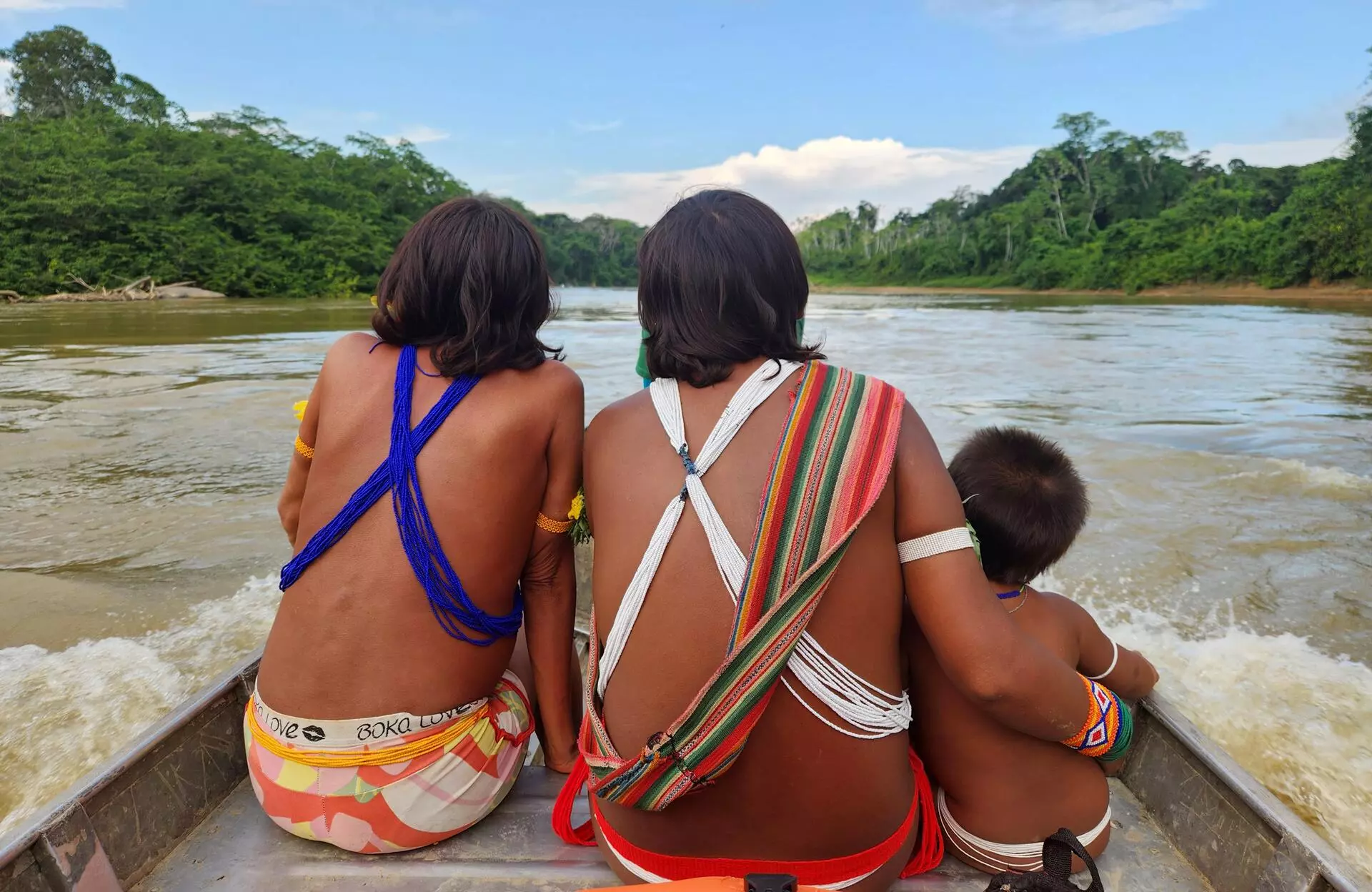
Josane, Guiomar, and little Evilene are part of the resistance formed by Yanomami women, who have been hardest hit by government abandonment of the territory in recent years. Photo: Ana Maria Machado/ISA





